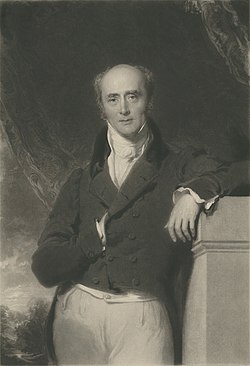Earl Grey
This article includes a list of general references, but it lacks sufficient corresponding inline citations. (May 2008) |

Earl Grey is a title in the Peerage of the United Kingdom. It was created in 1806 for General Charles Grey, 1st Baron Grey. He had already been created Baron Grey, of Howick in the County of Northumberland, in 1801, and was made Viscount Howick, in the County of Northumberland, at the same time as he was given the earldom. A member of the prominent Grey family of Northumberland, he was the third son of Sir Henry Grey, 1st Baronet, of Howick (see below). Lord Grey was succeeded by his eldest son, Charles, 2nd Earl Grey. He was a prominent Whig politician and served as Prime Minister of the United Kingdom from 1830 to 1834, which tenure saw the passing of the Great Reform Act of 1832. In 1808 he also succeeded his uncle as third Baronet, of Howick.
History
The second earl was succeeded by his second, but eldest surviving son, Henry, 3rd Earl Grey. He was also a Whig politician and served under Lord John Russell as Secretary of State for War and the Colonies from 1846 to 1852. On his death the titles passed to his nephew, Albert, 4th Earl Grey. He was the son of General the Hon. Charles Grey, third son of the second Earl. Lord Grey was governor general of Canada between 1904 and 1911. His son, Charles, 5th Earl, was a major in the Army. He died without male issue and was succeeded by his second cousin once removed, Richard, 6th Earl, and present holder of the titles. He is the great-great-grandson of Admiral the Hon. George Grey, fourth son of the second earl.
The Grey Baronetcy, of Howick in the County of Northumberland, was created in the Baronetage of Great Britain in 1746 for Henry Grey, High Sheriff of Northumberland in 1738. A member of an old Northumberland family, he was eighth in descent from Sir Thomas Grey, of Heton, elder brother of John Grey, 1st Earl of Tankerville (see the Earl of Tankerville, 1418 creation) and fifth in descent from Sir Edward Grey, of Howick, uncle of William Grey, 1st Baron Grey of Warke. In 1720 he married Hannah, daughter of Thomas Wood of Fallodon near Alnwick in Northumberland. Grey was succeeded by his eldest son, the second baronet. He represented Northumberland in the House of Commons. He died unmarried and was succeeded by his nephew, the second Earl Grey. For further history of the baronetcy, see above.
Several other members of this branch of the Grey family have gained distinction. The Hon. George Grey (1767–1828), second son of the first Earl Grey, was created a baronet, of Fallodon in the County of Northumberland, in 1814 (see Grey baronets) and was the father of Sir George Grey, 2nd Baronet, and the great-grandfather of Edward Grey, 1st Viscount Grey of Fallodon. The Right Reverend the Hon. Edward Grey (1782–1837), fifth son of the first Earl, was Bishop of Hereford from 1832 to 1837. His fourth son Sir William Grey (1818–1878) served as Governor of Bengal from 1866 to 1871 and as governor of Jamaica from 1874 to 1877. His daughter Sybil Frances Grey (d. 1945) was the mother of Prime Minister Anthony Eden, 1st Earl of Avon. Sir Paul Francis Grey, British Ambassador to Czechoslovakia from 1957 to 1960 and to Switzerland from 1960 to 1964, was the grandson of Francis Douglas Grey, a son from the second marriage of the Right Reverend the Hon. Edward Grey, Bishop of Hereford. The aforementioned the Hon. Charles Grey, third son of the second Earl, was a general in the Army. The aforementioned the Hon. George Grey (1809–1891), fourth son of the second Earl, was an admiral in the Royal Navy.
The family seats were Howick Hall and Fallodon Hall in Northumberland.
Legacy
Earl Grey tea is named after the second Earl Grey.[1]
The Grey Cup, the championship trophy for the Canadian Football League, is named after the fourth earl.[citation needed]
A column topped with a statue of Charles Grey, 2nd Earl Grey, (referred to locally as Grey's Monument) has a prominent location in the city of Newcastle upon Tyne.

Grey County in Ontario,Canada is named after Earl Grey.
In popular culture
In Mad Men season 6, episode 7 ("Man With a Plan"), Pete Campbell's brother, Bug, tells Pete their mother hit Bug's wife, Trudy, in the face with a dish towel when arguing about Earl Grey and Major Grey.
Earls Grey (1806)
- Charles Grey, 1st Earl Grey (1729–1807)
- Charles Grey, 2nd Earl Grey (1764–1845)
- Henry George Grey, 3rd Earl Grey (1802–1894)
- Albert Henry George Grey, 4th Earl Grey (1851–1917)
- Charles Robert Grey, 5th Earl Grey (1879–1963)
- Richard Fleming George Charles Grey, 6th Earl Grey (1939–2013[2])
- Phillip Kent Grey (b. 1940)
The heir presumptive is the present holder's son, Alexander Edward Grey (b. 1968).
Grey baronets, of Howick (1746)
- Sir Henry Grey, 1st Baronet (1691–1749)
- Sir Henry Grey, 2nd Baronet (1722–1808)
- Charles Grey, 2nd Earl Grey (1764–1845)
see above for further holders
See also
- Other Grey titles
- Grey Baronets
- Earl of Tankerville
- Baron Grey of Warke
- Earl De Grey (a slightly newer unrelated title for a different family)
Notes
- ^ Kramer, Ione (1990). All the Tea in China. China Books. ISBN 0-8351-2194-1= Pages= 180–181.
{{cite book}}: Check|isbn=value: invalid character (help) - ^ Reynolds, John (2013-09-23). "Cremation industry remembers Earl Grey as 'a lovely man' and 'inspirational leader'". Hampstead & Highgate Express. Retrieved 2013-09-23.
References
- Kidd, Charles, Williamson, David (editors). Debrett's Peerage and Baronetage (1990 edition). New York: St Martin's Press, 1990, [page needed]
- Leigh Rayment's Peerage Pages [self-published source] [better source needed]
- Lundy, Darryl. "FAQ". The Peerage.
{{cite web}}: External link in|publisher= - http://www.cracroftspeerage.co.uk/online/content/index699.htm
